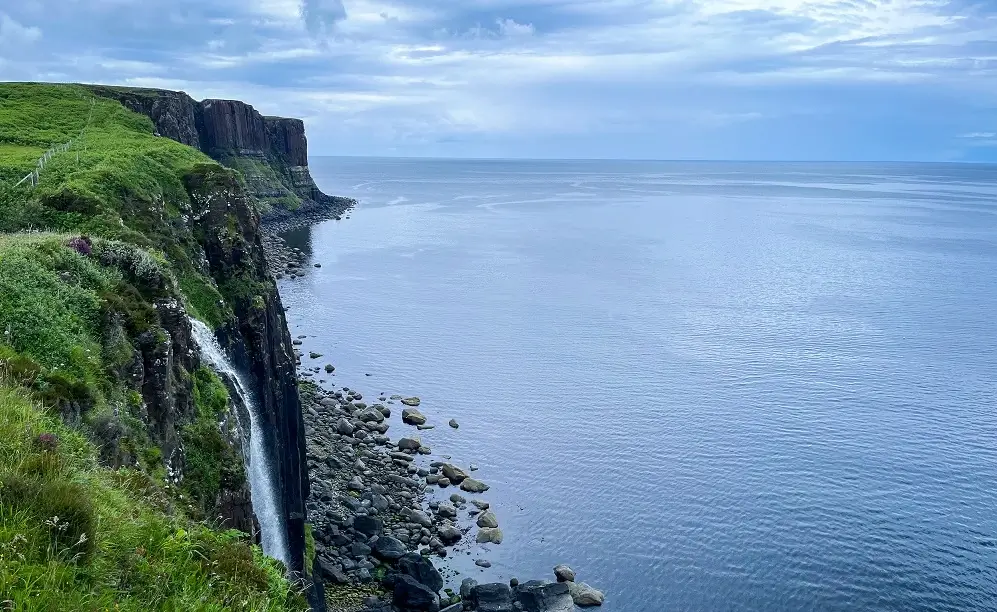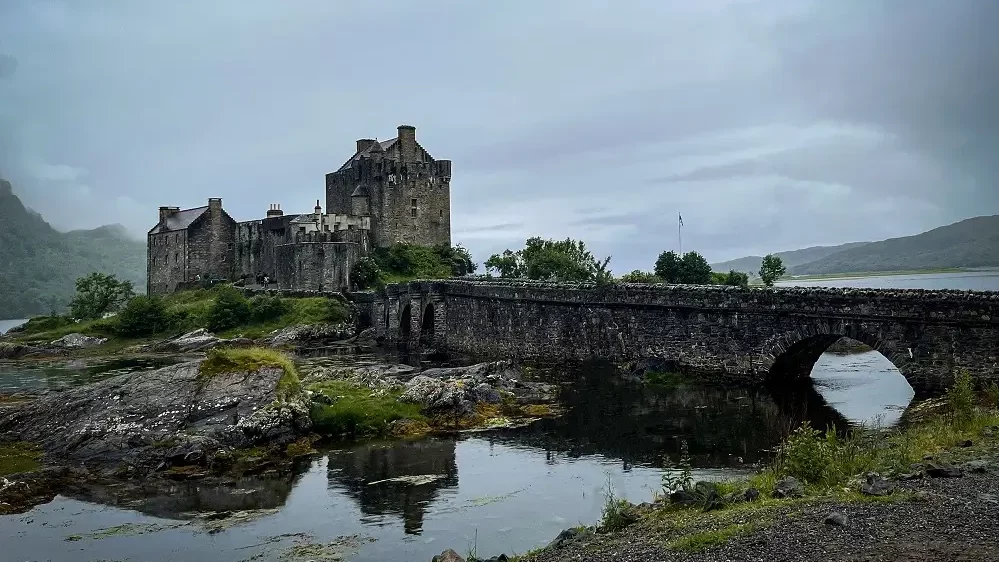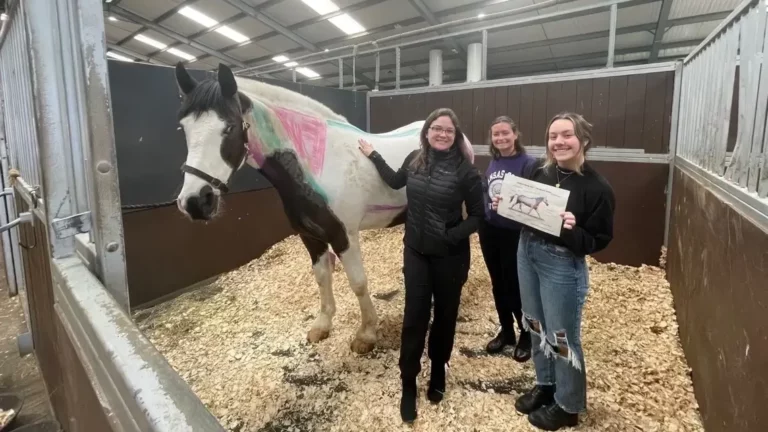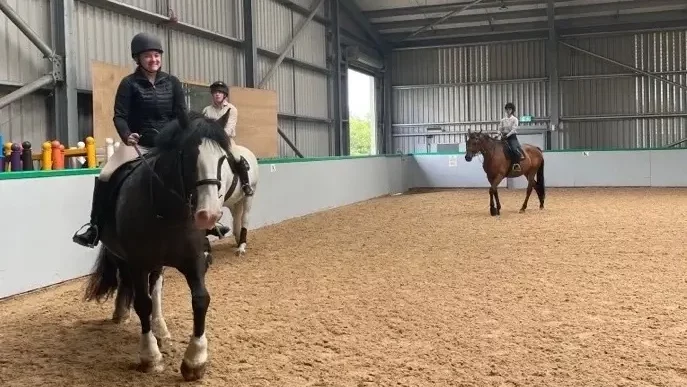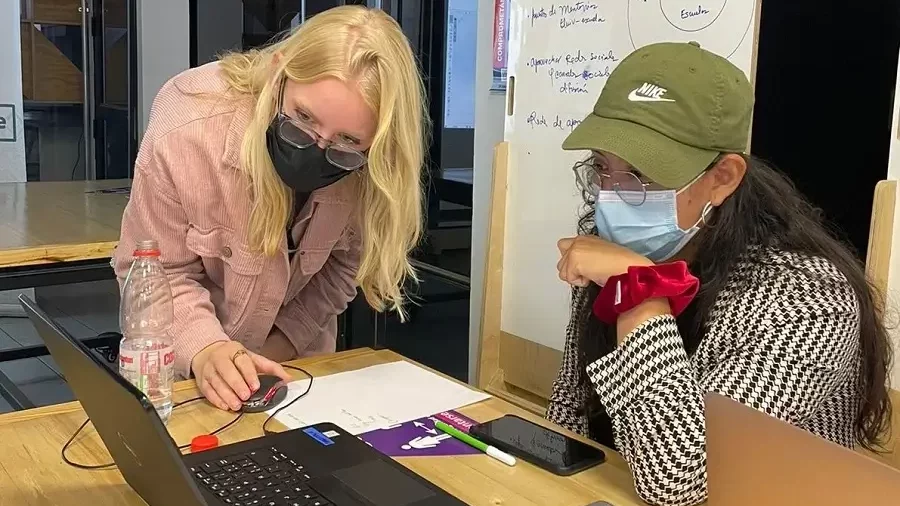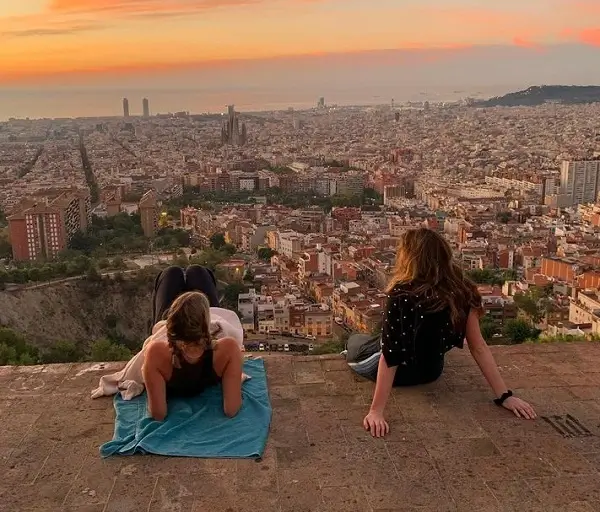Katie Ribbens participated in Adelante Equine Summer Program in Scotland. She takes us through her time in Edinburgh. Read Part 1 of her time in Scotland here.
Every time I looked out the bus window, I could practically hear the bagpipes playing through my head. The landscape was so distinctly Scottish that you could not help assigning music to the scene.
The beautiful green glens and the stream that carved through them had me pausing from my book to snap a mediocre iPhone photo every few seconds through the bus window. Our four-hour bus drive from Edinburgh to Inverness proved to pass quickly and enjoyably. I must admit, I read poorly as I ping-ponged my gaze from the window, to the page of my book, and back again.
We wound our way through the outskirts of Cairngorms National Park. I happily spotted many Highland cows and sheep dotting the hills, as well as a doe imposter that elbowed her way into the sheep herd. The lambs sprinted to shelter under a tree as pelting sheets of rain suddenly chased after them.
The glens harkened our arrival to the Highlands, their sharp angles a welcome sight. The lowered clouds added artistry to an already beautiful masterpiece, queuing “Misty Mountains” to my internal soundtrack. The breathtaking landscape reminded me a little of the Swiss Alps, albeit a little greener and a little darker with swirling steel rainclouds hovering over the peaks. Rocky outcroppings and stone wells peppered the glen, marking the battle of trees as they grappled among the jagged rocks to find purchase for their roots. It seemed every living thing in Scotland was prepared to fight for what belonged to them.
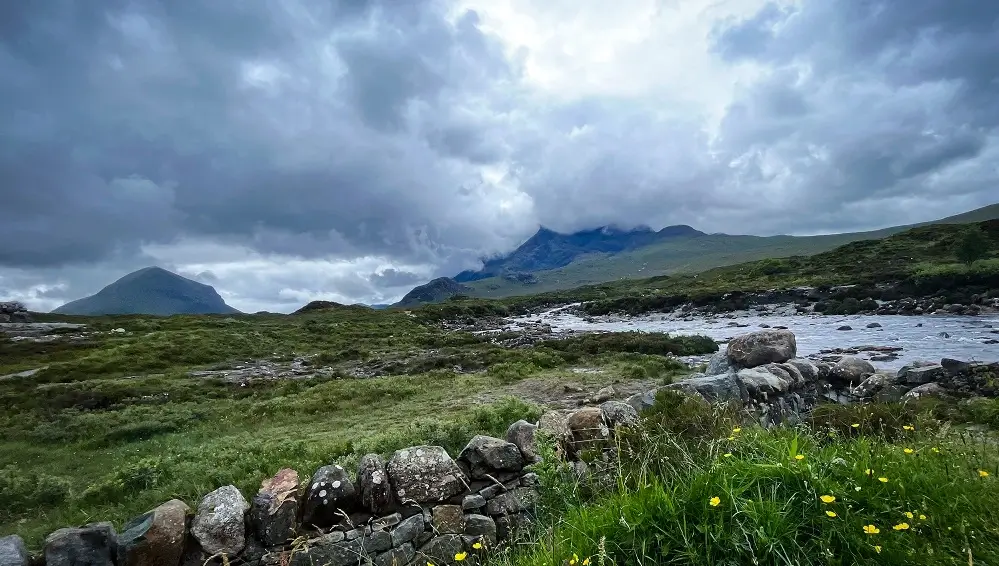
Early the next morning, we left our hostel to find our tour guide–his outfit complete with a kilt and sgian dhu–to take us to the Isle of Skye. I practically skipped to the bus as I prepared myself for the trip I’d been dreaming of for months. We were not even five minutes into the tour when our guide, Luke, told us we would make our first stop visiting the beasts of Loch Ness: the hairy coos! I took the proffered carrot chunk from Luke and did not even try to contain the wide smile spreading across my face. Everyone else grinned like an idiot too. As the cow’s tongue brushed my palm, I felt my brows rise in surprise. Its rough tongue resembled sandpaper, much like a cat’s. All too soon, Luke herded all 28 of us back to the bus as we threw longing glances over our shoulders at the beloved cows.
The rain visited intermittently throughout the day, like a bird flitting in and out: not frequently enough to be constantly looking overhead, but often enough that you are not surprised when it arrives again. Nessie decided not to make an appearance at Loch Ness, but Luke assured us that much of the depths remained undiscovered. The miles of water could be hiding anything, and indeed sequestered for decades an airplane that crashed in 1940. Even though we neglected to sight the Loch Ness Monster, we still gazed appreciatively at Urquhart Castle standing over the dark water.
As we continued toward Eileen Donan Castle (pronounced “ay-leen-do-nuhn”), Luke referred to his DJ background and set the mood with Scottish music, including the Outlander theme song. As it turns out, the song was written about Bonnie Prince Charlie’s escape to the Isle of Skye. I soaked in the haunting notes as the clouds crept down the glen, slowly swallowing the peaks and lending an air of mystery to the location. The Scottish music and tales of its history swept me to a world from centuries ago. As I gazed at the same landscape that the clansmen studied, I started to understand, if only a little, why they fought so hard to protect their home. My fascination with Scottish history began in high school with Mary Queen of Scots and only caught flame as I learned of William Wallace and Robert the Bruce. The more I learned, the more I was convinced that few countries could rival the beauty and heartbreak upon which Scotland stands. This juxtaposition is clearly displayed in the extremes of both its weather and its landscape.
Eileen Donan Castle, Luke told us, was a replica built in 1932, since the original castle was destroyed in 1719 during the Battle of Glen Shiel–the location of which we had driven through just moments earlier. The devastation on the land has since been soaked up by the ground and it stands defiant in its beauty. The castle, too, is an example of resilience. Even though the original stones burned along with the Jacobites’ ammunition, the castle is exquisitely beautiful. It stands as the center point where three lochs meet, casting its imposing reflection over the water.
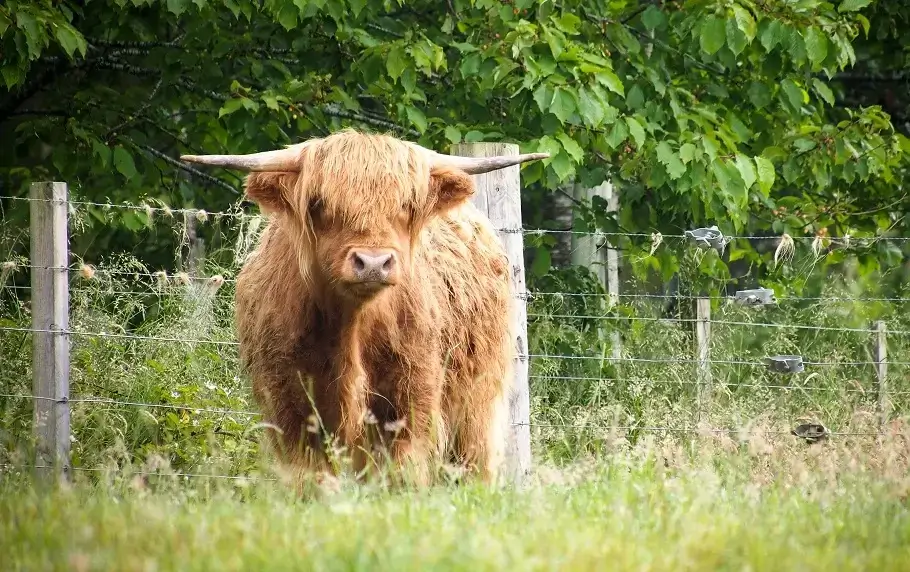
The volcanic Isle of Skye came into view as we crossed the Skye Bridge. I learned that Skye is prolific in dinosaur fossils; more were discovered on Skye than anywhere else in the world. I looked dubiously at the palm trees along the beach as I examined our breaths misting the air. Perhaps fairies kept the tropical plants alive. For, as we discovered at Sligachan, if you submerge your face into the enchanted water for ten seconds and then let it dry naturally, you will be blessed with eternal beauty. While we all good-naturedly complied with the ritual (“When in Rome,” and all that), I felt blessed enough just by taking in the staggering peaks, fairies or not.
For lunch, we stopped at the colorful seaside town of Portree. Our fish and chips were well worth the wait. Although I dazedly replied “yes,” when the man at the counter asked if I wanted salt and vinegar on my meal, I enjoyed the odd combination. In fact, I am tempted to bring some vinegar spray home and add the extra note of flavor myself. We ate quicker than normal because of the drizzle soaking our food, but it proved to be delicious regardless. On our way back to our bus, we passed the boats eagerly waiting for departure in the harbor, straining against the anchors that held them back from the open sea.
The eccentric–but iconic–sight of Old Man of Storr filled our field of view as we moved toward it. The landscape formed when the rock slipped and implanted itself several feet below. Luke promised he was taking us to the best viewing point with a bonus waterfall, so we trustingly fell into line behind him as he led us up a rain-soaked path that ran parallel to the waterfall. I yanked my foot back as I discovered that the ground sank several inches into muddy water the moment I put my weight down. Since the damage was already done to my poor light-colored shoes, I shrugged and continued up the path, doing my best not to slip. The treacherous path was made more treacherous by the recent rainfall, but our entire group forged its way to the top. Luke was right. The view was beautiful, especially with the waterfall in the foreground. A few twisted ankles and ruined shoes were a small price to pay.
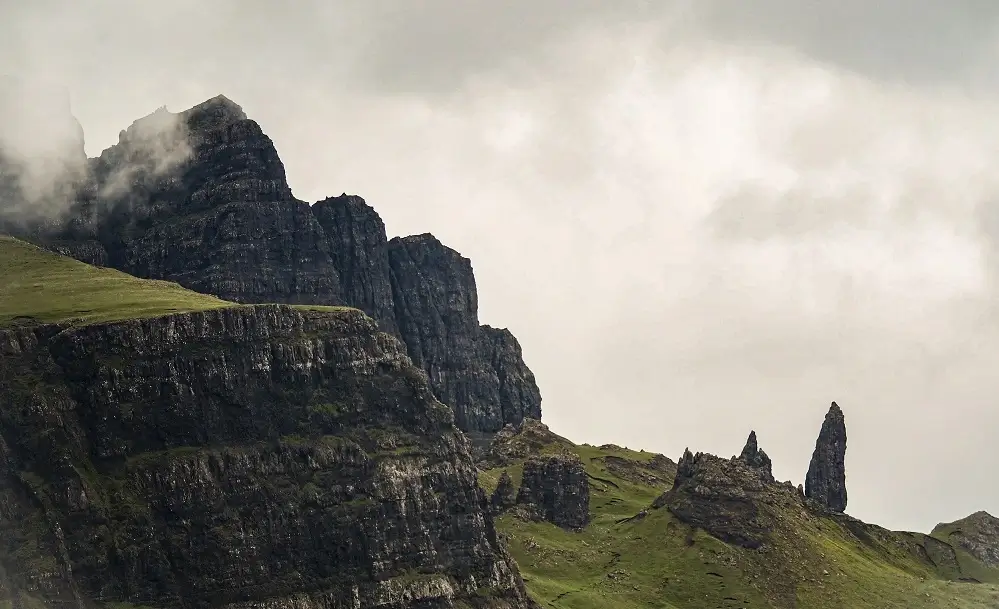
The next stop within the Inner Hebrides (“heh-bruh-deez”) would give Norway’s fjords a run for their money. The calm water soaked up every color of the sky, living up to its namesake. The steep cliffs perfectly framed the tranquil scape. The two waterfalls, one running into the other, swelled red and brown as it stole mud from the path. I felt the customary eagerness as we sped toward our next stop, but also reticence. Kilt Rock was our final stop on the isle, and the one I most looked forward to. Luke told us that the rock was named because the rock mimics the plaits of a kilt. There is also a tale that when the sun shines on the waterfall and the conditions are just right, it also gives a rainbow effect over the rock face, transforming it into a tartan. No matter how many photographs I viewed before the trip, there is still something otherworldly about seeing a waterfall dive off the cliff into the depths below. Although I never wanted to leave, I reluctantly joined the rest of the group as we started our journey back to Inverness.
As we wound through the isle once more, I reflected on the tidbits of history Luke had shared. I felt the legacy of the Jacobites as much in Inverness as I did in the key surrounding areas. While erratic public transport foiled our attempt to visit Culloden, I still left feeling as though I experienced a special part of history. We drove past the seven standing stones erected in tribute to the seven Jacobite officers that sacrificed themselves to save Bonnie Prince Charlie. In Eileen Donan Castle, we studied carefully preserved objects from the Jacobite Rebellion, including a war flag and a lock of Bonnie Prince Charlie’s hair (it was a dirty blonde, by the way, adding to his feminine looks). Luke told us that since Gaelic was outlawed after Culloden, Inversions spoke some of the best English in Scotland. I cannot say I understood the locals better than those in Edinburgh when they speak in a rapid tempo and their words run together into the distinct brogue, but I don’t mind, so long as I get to keep listening to the iconic Scottish accent.
As I once again picked up Outlander for the bus ride home, I grinned as the book mentioned the people and places I had just left behind.
